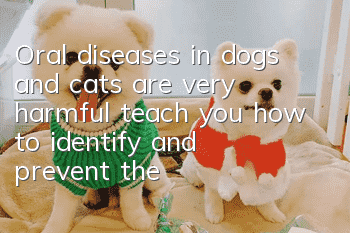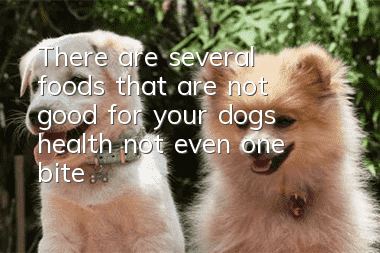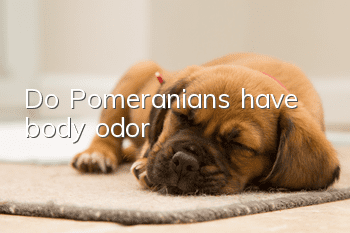Oral diseases in dogs and cats are very harmful, teach you how to identify and prevent them!

Introduction
Oral diseases mainly include "inflammation of the oral mucosa, lacerations and ulcers of the tongue, bleeding and swelling of the teeth, gingivitis, periodontitis, alveolar abscess and other diseases. The occurrence of these diseases is largely related to the owner's lack of attention to the pet's oral cavity. Hygiene is related to improper daily care methods.
Why should you brush your dog’s and cat’s teeth?
According to statistics, more than 80% of pets have oral diseases, but animals cannot speak, so when they are discovered, they are often extremely serious. When oral inflammation is severe, it often causes discomfort and pain. In addition to malnutrition due to difficulty in eating, germs may spread to other important organs of the body through the wounds in the mouth and blood, possibly causing fatal diseases.
Clinical manifestations of oral diseases
Bad breath, brown or yellow tartar near the gums, bleeding gums when chewing food, swollen gums, pain, loose teeth, abnormal increase in saliva, loss of appetite, listlessness, etc.
How to brush your dog's teeth
Dogs: You should start brushing your dog’s teeth 2-3 times a week when he is 6 months old. The dog will be uncomfortable and resist at first, but if you insist on doing it, you will develop better habits. Method: First dip a gauze strip into a little saline solution and wrap it around your index finger, then wipe the gums and gaps between the teeth in sequence, using gentle movements to avoid damaging the gums; after the dog adapts, dip in a little pet toothpaste and brush its teeth. This toothpaste No need to rinse your mouth, just let it dry on its own. The above operation can last for 2 weeks. After the dog is fully adapted, use a dog-specific toothbrush to brush its teeth. After long-term persistence, you can get the ideal nursing effect.
Cats: Cats can have different problems than dogs because most cats will not allow their teeth to be brushed. Method: Before brushing your cat’s teeth, prepare the necessary tools. For example, pet cat toothbrush, toothpaste, etc.; of course, when training a cat to brush its teeth for the first time, parents can choose to use soft cotton gauze dipped in an appropriate amount of saline to help the cat brush its teeth.
What to do if your pet won’t let you brush your teeth
a. Breath fresheners and chewable tablets: can improve the oral odor of animals and reduce the adhesion of dental plaque. Mouthwash for pets: spray directly on teeth, or mix into drinking water.
b. Diet/pet food: Dry food is best for their teeth, because dry food has a frictional effect and helps remove plaque on the crowns, and dry food is not as easy to stuff and push in as soft canned food. Within the gingival crevice.
c. Gum exercise: Chewing bones can cause gastrointestinal problems in pets. Chewing bones or things harder than teeth may cause damage or fracture to dogs and cats’ teeth. Teeth that appear pink, purple, gray or tan are signs that they are about to become necrotic or have already become necrotic. Let animals chew on toys and cakesDry, artificial bone, knotted rope, etc., provide exercise opportunities and friction for the gums, helping to exercise the gums and remove plaque on the crown.
Under what circumstances cannot you brush your teeth?
a. Severe periodontitis requires a period of oral treatment before you can brush your teeth.
b. In the first three days after teeth cleaning, the gums have not yet been repaired, so it is not suitable for brushing.
How to prevent
a. Dogs should start brushing their teeth 2-3 times a week from the age of 6 months. The dog will be uncomfortable and resist at first, but if he persists, he will develop better habits.
b. Don’t feed your dog too much sweets to avoid tooth decay. You can feed it various chewing bones or toys, which can not only exercise the bite force of the dog's teeth, but also play a role in cleaning tartar and tartar.
c. Regularly supplement some vitamin B complex drugs to reduce the incidence of disease.
d. Elderly dogs with a lot of dental calculus can go to the hospital regularly for teeth cleaning and care.
e. If oral ulcers, red and swollen gums, etc. occur, you can use warm saline to clean the disease and rub iodine, glycerin or antibiotics. If the disease is serious, you should go to the hospital for examination and treatment as soon as possible.
Summary
As the saying goes, “Disease enters through the mouth,” and animals are no exception. For the health of our pets, we must provide regular care and health care to our pets in a planned and regular manner. This can effectively avoid and prevent the occurrence of oral diseases in pets.
- What kind of food should dogs eat?
- Teach you four steps to identify good dog food!
- What should you pay attention to when choosing a dog house?
- Dog's nose is leaking clear water
- Dog allergy symptoms
- Things you need to pay attention to when grooming your dog in winter
- What are the symptoms of dog poisoning?
- What are the signs of successful pregnancy in dogs?
- Introduction and selection method of Giant Schnauzer
- What foods are harmful to dogs’ health?



